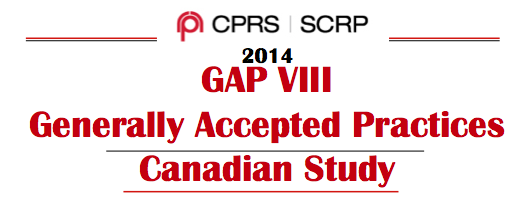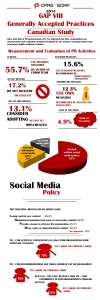Amy Thurlow, Mount Saint Vincent University. For the GAP (VIII) Canada Research Team.
For the first time, Canadian researchers have surveyed senior public relations professionals to determine how PR is practiced in this country.
Lead by an MSVU research team, the GAP (Generally Accepted Practices) study was conducted this past year to develop a database of information on public relations practice for Canadians. The survey was rolled out as part of a partnership between CPRS (the Canadian Public Relations Society), the Communication + Public Relations Foundation, and the Global Alliance – and lead by the USC Annenberg GAP VIII project which has conducted a similar project in the United States over the past decade. Joining Canada and the United States in this year’s research were South Africa, Australia, Brazil and New Zealand. Stay tuned in the coming months for some interesting comparative analysis of these international findings.
In the Canadian study, we surveyed only senior public relations practitioners, and asked them about how PR is practiced in their organizations. The survey itself was 78 questions in length and we received 197 responses (122 fully complete and qualified). This means we have a vast amount of information to work with. We look forward to continuing to analyze this data here at MSVU as faculty and student researchers work together to identify benchmarks for future research and identify interesting research questions for further study.
Demographics (Gender and Salary)
Our respondents were 72% Female; 28% Male. When asked, “What percentage of your PR/COM staff is female?” One third of respondents answered 100%. Despite this representation of women in the field, salary information indicated that a gender pay gap still exists. Our senior communicators reported an average salary of Average Salary of $105,000. Within that there was still quite a range from a minimum of $30,000 to a maximum of $350,000. Broken out by gender, the average salary for males was $127,000 while for females it was $95,500.
Findings
Although we are still at an initial stage of our analysis, several things have jumped out us right away. These include descriptions of the core responsibilities of Canadian PR departments, the importance of social media to PR practice, the lack of attention being paid to formal measurement and evaluation, and the importance of PR to decision making within the dominant coalition.
Core Responsibilities
Respondents told us that the core responsibilities of their PR/COMM departments were very clearly located in five key areas. Media Relations was clearly a key responsibility across the board, with social media practices factoring significantly into departmental responsibilities as well. (Exhibit 1).
Exhibit 1: Identify the core areas of responsibility of your PR/COMM department
| Media relations | 95.9% |
| Corporate communication/reputation (other than advertising) | 86.9% |
| Social media participation | 84.4% |
| Social media monitoring | 83.6% |
| Corporate image (logo usage, etc.) | 78.7% |
Social Media
Social media emerged as an important area of PR practice in Canada. Along with this, however, respondents indicated some apprehension as well. When asked to identify concerns they may have with an increased social media presence, respondents indicated that “losing control of content” and “diminished reputation from poor or inaccurate content” were their two most pressing concerns. Only 18% of respondents had no concerns about social media at all.
| Measurement and evaluation Survey results around measurement and evaluation indicate that there is still a gap in terms consistent measurement of PR/COMM initiatives. 17.2% of respondents indicated that they do not measure or evaluate PR programs at all. And of those who did use evaluation strategies, the majority were limited to social media based approaches such as tweets and re-tweets, likes on Facebook, etc. |
C-Suite perceptions
PR/COMM departments appear to be having a positive impact within the dominant coalition in terms of decision making. 79% of respondents agreed or strongly agreed with the statement, “PR/COMM recommendations are taken seriously by senior management (CEO, Chairperson, COO) in my organization.” And 75% agreed or strongly agreed with the statement, “PR/COMM actively participates in long-term organization-wide strategic planning.” Less confident was the response to C-suite perceptions of the PR/COMM contribution to the bottom line. Just 52% of respondents agreed or strongly agreed with the statement, “Our CEO/top executive believes that PR/COM contributes to our organization’s financial success.”
Click on the image below to see an infographic of the GAP findings






